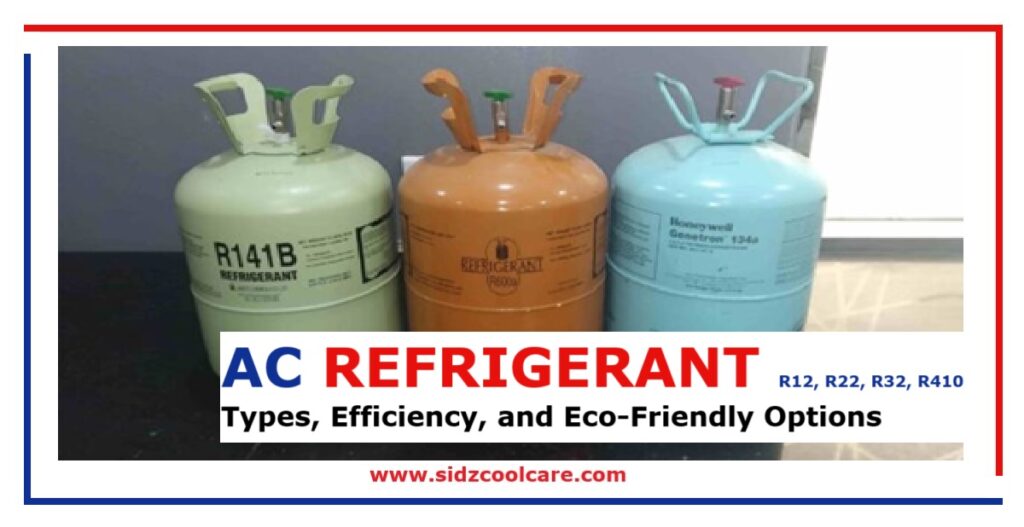Air conditioners rely on refrigerants to absorb and release heat, ensuring a comfortable indoor temperature. Understanding different types of AC refrigerants is crucial for selecting an efficient and eco-friendly cooling system. In this article, we will explore what refrigerants are, their types, and how they impact the environment and AC performance.
What is AC Refrigerant?
AC refrigerant is a chemical compound that cycles through the air conditioning system, transferring heat from indoor spaces to the outside environment. It undergoes a phase change from liquid to gas and back, enabling cooling. The efficiency and environmental impact of an AC unit largely depend on the type of refrigerant used. Modern refrigerants are designed to be more energy-efficient and environmentally friendly compared to older, ozone-depleting options.
Types of AC Refrigerants
Over the years, different refrigerants have been used in air conditioning systems, evolving to meet environmental and efficiency standards. Here are the most common types:
1. CFC Refrigerants (Chlorofluorocarbons) – R12
- Usage: R12 was one of the earliest refrigerants used in both residential and commercial air conditioning and refrigeration systems. It was widely used in refrigerators, automobile air conditioning, and commercial cooling systems.
- Environmental Impact: R12 is a major contributor to ozone depletion and has an extremely high Global Warming Potential (GWP). Due to its chlorine content, it breaks down ozone molecules in the stratosphere, leading to ozone layer thinning.
- Phase-out: Due to the Montreal Protocol (1987), R12 was completely banned in most countries by the mid-1990s. It has been replaced by HFCs and HFOs in modern air conditioning systems.
2. HCFC Refrigerants (Hydrochlorofluorocarbons) – R22
- Usage: R22, also known as Freon, was widely used in residential and commercial air conditioning units until the early 2000s. Many AC units manufactured before 2010 still use R22.
- Environmental Impact: Although less harmful than R12, R22 still contains chlorine, which contributes to ozone depletion. Its GWP is 1810, making it significantly more harmful than modern alternatives.
- Phase-out: The U.S. EPA (Environmental Protection Agency) and several other regulatory bodies have banned R22 production and import as of 2020. Existing AC units using R22 can still operate, but require costly maintenance and refrigerant recycling.
3. HFC Refrigerants (Hydrofluorocarbons) – R410A, R134A
- Usage: HFCs like R410A and R134A are currently among the most commonly used refrigerants in residential and commercial air conditioners. R134A is widely used in automobile ACs and refrigerators.
- Environmental Impact: Unlike CFCs and HCFCs, HFCs do not contain chlorine, meaning they do not cause ozone depletion. However, they still have a high GWP (R410A has a GWP of 2088), contributing significantly to global warming.
- Efficiency: R410A operates at higher pressures than R22, requiring specially designed components in AC systems. It provides better cooling efficiency and heat transfer, making AC units more effective.
- Phase-out: Due to their high GWP, HFCs are being gradually replaced by low-GWP refrigerants like R32 and HFOs in newer AC models.
4. HFO Refrigerants (Hydrofluoroolefins) – R1234yf, R1234ze
- Usage: HFOs represent the next generation of refrigerants, primarily used in automotive AC systems, commercial cooling units, and energy-efficient air conditioners.
- Environmental Impact: HFOs have an ultra-low GWP (R1234yf has a GWP of 4, compared to 2088 for R410A). They are designed to be non-ozone-depleting and are much safer for the environment.
- Efficiency: HFOs provide excellent heat transfer properties, improving AC system performance and reducing energy consumption.
- Phase-out: HFOs are not being phased out; rather, they are replacing older refrigerants in many applications due to their eco-friendly properties.
5. Natural Refrigerants – R290 (Propane), R600A (Isobutane), R717 (Ammonia), R744 (CO2)
- Usage: Natural refrigerants are widely used in commercial refrigeration, industrial cooling systems, and eco-friendly residential AC units.
- Environmental Impact: These refrigerants have extremely low or zero GWP and do not deplete the ozone layer. They are considered some of the most sustainable options for cooling.
- Efficiency:
- R290 (Propane): Highly energy-efficient and used in small AC units and refrigerators.
- R600A (Isobutane): Common in household refrigerators and small cooling units.
- R717 (Ammonia): Highly efficient but toxic and corrosive, requiring specialized handling. Used in industrial cooling and ice plants.
- R744 (CO2): Works well in low-temperature refrigeration and high-pressure AC systems.
- Safety Concerns: Some natural refrigerants (like propane and isobutane) are flammable, while others (like ammonia) can be toxic. However, they offer the best balance between efficiency and environmental impact when handled correctly.
Choosing the Right AC Refrigerant
When selecting an air conditioner, consider the following:
- Eco-Friendliness: Opt for refrigerants with low GWP, such as R32, R290, or R1234yf, to reduce environmental impact.
- Efficiency: Refrigerants like R410A and HFOs provide superior cooling performance, making AC units more energy-efficient.
- Regulations: Many countries have banned older refrigerants like R12 and R22, so ensure that your AC unit complies with the latest environmental policies.
- System Compatibility: Some refrigerants require specialized compressors and cooling components. For example, switching from R22 to R410A requires an entirely new AC system.
Conclusion
AC refrigerants play a crucial role in cooling performance and environmental impact. As older refrigerants like R12 and R22 are phased out, newer, eco-friendly options like R32, R410A, and HFOs are becoming standard. When choosing an AC unit, consider refrigerant type, efficiency, and environmental regulations for optimal cooling and minimal environmental harm.


